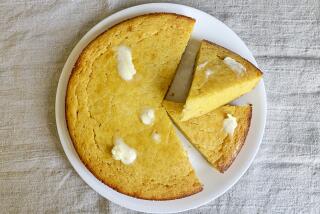GARDENING : In General, Kernel Corn Ranks as Major Sweet
- Share via
The good ‘ol days seemed to have bluer skies, greener grass and more toothsome apples. Perhaps it was so. One thing those good ol’ days definitely did not have was sweeter sweet corn.
Only recently have plant breeders found new genes that shoot the sugar content of sweet corn sky-high.
Papoon corn, the first recorded variety of sweet corn, probably originated as a chance mutation of a single gene of field corn. That gene, the so-called sugary gene (abbreviated su), raised the sugar level in corn seed to 10%, from 4%.
Gardeners have tried to make the most of that 10% ever since 18th-Century Plymouth, Mass., colonists grew Papoon corn. We pick an ear just when each kernel is creamy and as sweet as can be.
Because sugars in corn start changing to starch as soon as the ear is picked, we eat the corn right out in the garden or else rush it to the kitchen to a pot of already boiling water. In only one day, half that sugar will turn to starch.
A few decades ago, sweet corn sweetness took a quantum leap as a result of two genes.
The first gene--called the shrunken-2 gene (abbreviated sh2) because of the way the dried kernels shrivel up--pushes the sugar level in corn up to a whopping 37%. Not only that, but even two days after picking, that corn still has 29% left. The variety Illini Xtra Sweet was the first of the appropriately named “supersweet” or “extrasweet” sweet corns. Other varieties with this gene are Early Xtra Sweet, Starstruck and How Sweet It Is.
The second gene responsible for sweeter sweet corn is the sugar-enhanced gene (abbreviated se). The se gene is effective only in combination with the su gene of regular sweet corn varieties, and the combination of the two genes results in varying degrees of sweetness.
Still no need to scurry to the kitchen with se varieties, because they also retain their sweetness for a long time. Kandy Korn EH, Pearls ‘n Gold EH, Silverado and Snow Queen EH are varieties with the se gene. Many of these varieties have that “EH,” which stands for “everlasting heritage,” in their names.
Despite the sugary sweetness in these new sweet corns, they are not for everyone. First of all, these new varieties need special care. The seeds are finicky and will rot just as soon as grow if planted in soils that are too cool, too dry or too wet. Seems like soil microorganisms also enjoy that extra sweetness. And even after the seeds have been coaxed to germinate, the resulting seedlings often lack vigor.
The sweeter sweet corns can lose almost all their sweetness if the wrong pollen blows onto their silks. If an sh2 variety is cross-pollinated with a standard sweet corn, kernels on both will taste dry and starchy like those of field corn.
Cross-pollination of varieties with the se gene with other types of sweet corn results in standard sweet corn. The only way to minimize such contamination is to separate varieties by at least 250 feet, or else plant varieties whose maturities differ by more than two weeks.
What about flavor: Is sweetness all we want from sweet corn? The sweeter sweet corns tend to taste more watery and lack a “corny” flavor. Regular corn varieties--including old varieties such as Golden Bantam, Country Gentleman and Silver Queen--are delectable if picked at just the right stage, then eaten within minutes. Corn with 37% sugar tastes too sweet to many gardeners.
Taste a few types of sweet corn, and see which ones suit your taste buds.




